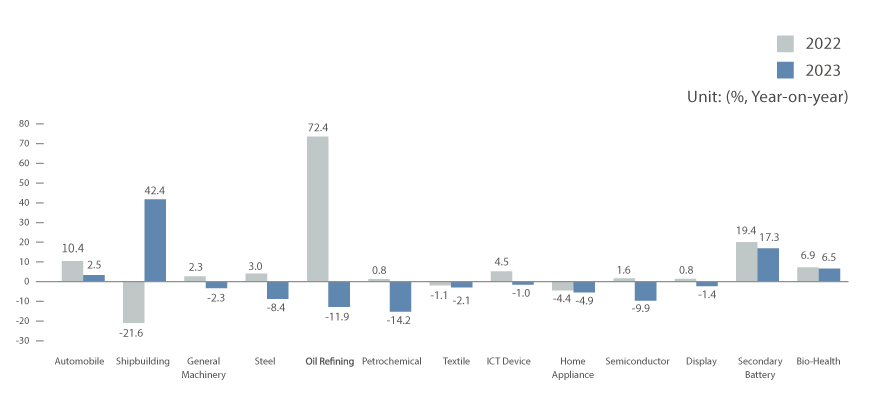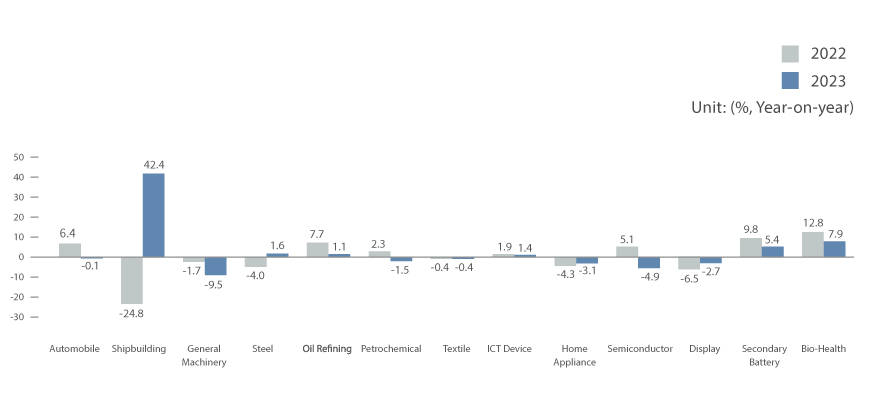Industry Focus
- Home
- Investment Opportunities
- Latest Information
- Industry Focus

Changes in Internal and External Conditions and Impacts by Industry in 2023
Moreover, the demand outlook for Korea's main export destinations, including the US, European countries, and China, is forecast to face sluggish or decreased growth of import demand in the aftermath of the global economic downturn. There is a possibility that the homegrown market may face slow economic growth at home and abroad, rising price and interest rates, poor demand industry, and other aggravating domestic demand conditions at large. In terms of supply, national supply capacity is likely to improve, boosted by the normalization of parts supply and demand, the expansion of new manufacturing facilities in response to internal and external demands, and the rise of operating capacity. Yet, there are concerns about contraction in some industries affected by the expansion of overseas production and changes in the product structure.
2023 Outlook for Korea’s 13 Key Industries
(Exports) Expected to decrease by 4.0% on-year due to sluggish external demand caused by the global economic slowdown
ㆍ Exports of 13 key industries: (2021) USD 501.2 billion → (2022) USD 539.7 billion → (2023) USD 517.9 billion
ㆍ Export Share of 13 Key Industries: (2021) 77.8% → (2022) 77.8% → (2023) 77.1%
- (Machinery industry) Despite the decrease in general machinery (-2.3%), brisk exports of automobiles (2.5%) and shipbuilding (42.4%) are expected to drive a 5.7 % increase in the machinery industry as a whole.
- (Material industry) Expected to slip by a great margin of 11.2 % from the previous year due to falling unit prices and slowing import demand
- (IT & new industries) Expected to fall by 5.0% compared to the previous year due to sluggish demand and increased external production amid economic contraction

(Domestic demand) The decline continues or growth is limited in many industries due to the economic slowdown and weak consumer sentiment
- (Machinery industry) Local demands for automobiles and general machinery continue to decrease, except for shipbuilding.
- (Material industry) The overall economic activity is expected to contract due to sluggish front industry’s business condition and private spending crunch.
- (IT & new industries) Despite poor performance in home appliances and displays, ICT devices, semiconductors, and secondary batteries are expected to draw a domestic demand for the IT & new industries.
(Production) In most industries, except for shipbuilding (42.4%) and steel (1.6%), growth rates have slowed or turned to decline due to negative factors such as weak domestic demand in tandem with sagging exports and inventory accumulation
- (Machinery industry) While the growth of automobiles (-0.1%) and general machinery (-9.5%) is to decline due to low domestic demand and exports, shipbuilding is forecast to show a significant increase of 42.4% as the orders before the outbreak of COVID-19 go into production.
- (Material industry) Steel (1.6%) and oil refining (1.1%) are expected to edge up slightly, but petrochemicals (-1.5%) and textiles (-0.4%) are expected to decrease due to deteriorating internal and external conditions.
- (IT & new industries) Although production of home appliances (-3.1%), semiconductors (-4.9%), and displays (-2.7%) declines, owing to sluggish demand at home and abroad, that of ICT devices (1.4%), secondary batteries (5.4%), and bio-health (7.9%) keeps an upward trend thanks to greater demand.

(Import) Expected to decrease by -1.2% from the previous year's uptick (8.0%), attributable to the stabilization of unit price and a slowdown in the domestic economy.
- (Machinery industry) Shipbuilding is expected to jump due to overseas equipment imports. By contrast, a slight decrease in automobiles and general machinery leads to the expectation of a 0.4% increase as a whole.
- (Material industry) Expected to fall by 7.7% in all industries, except for textiles, due to dropping unit price and volume.
- (IT & new industries) Expected to inch up 2.0% thanks to increased imports in the IT & new industries, led by the expansion of internal demand for ICT devices, semiconductors, and secondary batteries, but the growth rate is conspicuously diminished from the previous year (11.7%).
- (Machinery industry) Automobiles, shipbuilding, general machinery
- (Material industry) Steel, oil refining, petrochemicals, textiles
- (IT & new industries) ICT devices, home appliance, semiconductor, display, secondary battery, bio-health
※ Source: Korea Institute for Industrial Economics and Trade
< The opinions expressed in this article are the author’s own and do not reflect the views of KOTRA.>










